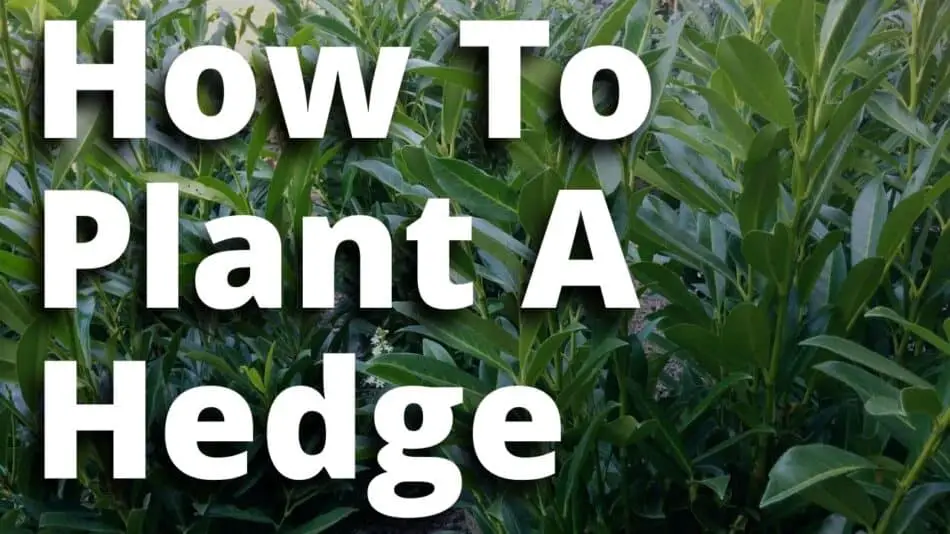I have been asked many times “How do I get my hedges to grow faster?” You have panted a hedge for privacy, but you need it to put in some growth before you get any of that privacy.
The best way to encourage the fastest growth of your hedges is to make sure you mulch, water, prune and check on one to two times a week, in addition to using a good starter fertilizer.
Starter fertilizer. Good starter fertilizer will be lower in nitrogen, and higher in potassium and phosphorus, with the addition of beneficial mycorrhizae. When you need hedges top growth, you first need the root growth to power, feed, and sustain that growth.
Mycorrhizae have been proven to greatly increase root coverage and that is highly beneficial to faster hedge growth.
Nitrogen should only be used in moderation for three reasons
- Too much can burn the roots, slowing your growth
- The excess will only wash away and is a waste of money
- Top growth that is pushed too hard is weak and susceptible to insects and disease.
These 3 things will not speed your privacy hedge, so do not overfeed with nitrogen fertilizer.
Mulch. A 3-inch layer of biodegradable mulch such as bark, pine needles, or compost laid down surrounding the shrub base (not touching, leave a few inches around the trunk) will moderate the soil temperature, conserve moisture, and control weeds in the important root growth zone.
Prune. Pruning promotes growth. Prune a little off the top as this pruning will trigger the plant to enter into a growth stage. Just like if it had been chewed on by deer, this will send the signal to your plant to grow to replace the foliage the critter ate. Pruning also encourages latent buds, lower down on the stem, to grow and make your hedge thicker, fuller, and bushier.
Check on your hedge. You can talk to them if you like, but the reason to actually go out and over to your new hedge is up close you can see a problem before it starts to suppress growth.
Check if your irrigation is working properly if your hedge is dry or is drowning making the soil is muddy. See if a deer or rabbits have just found and are starting to chew on your plants, in time for you to apply a repellant before the damage is extensive.
Turn over a few leaves and look at the undersides, and insects or eggs?
Does your plant just appear ‘off’ from when you have looked before? If you do not know why, this is the time to call a gardening friend, ask at the local garden center or the agricultural extension agent. Most stressors can be corrected before extensive damage is done. You will be able to save the investment of time, labor, and money you have invested in your hedge.
To determine if you can expect your hedge to grow faster, you need to know what type of plant you have and research how much growth you can expect a year. Most plants will not put on as much top growth as typical for the plant the first year or even two. The plant is focusing its resources, as it should, on growing the roots to support the top growth. If you are in a hurry, plant shrubs that are the minimum acceptable height already.
Should you prune a hedge you want to grow fast?
Yes, you do want to prune a plant to encourage the growth of your hedge. I am sure you have seen those overgrown hedges or foundation plants that are sparse at the bottom and very thick at the very top. This comes from either delaying pruning until the plants reached as tall as desired, and then trying to keep them there. (Or they are simply very old and overgrown plantings that need either to have rejuvenation pruning or pulled out and replaced)
Pruning will not only trigger the plant to enter a growth phase but will make a thicker, bushier plant as time goes on.
Will fertilizer make my plants grow faster? Maybe. However, if you push hedge plants to grow faster with the fertilizer you will either burn the roots with too much fertilizer, or the new growth will be weak, and susceptible to insects and disease. Use fertilizer if there is a nutrient deficiency of some type, but just adding fertilizer just to speed growth is like using steroids to get muscles faster. Yes, it may, but at a long-term cost.
Causes of stunting or slow growth:
- Wrong plant for the area. If you did not get a plant that is suited for the area it is being asked to grow in, moisture requirements, hardiness zones, hot tolerances, sun requirements or tolerance, or soil preferences, the growth will be stunted, and you will constantly have to work hard to encourage the planting. Do your research first to get the right plant in the right place for the right purpose, and healthy, thriving hedges are easy! Click here to get the right plant every time!
- Improper planting. If your hedge was not planted properly, it is handicapped from the start and growth will be stunted. Click here to find out how to plant your hedge to get it off to the best start.
- The hedge plants are not established yet. Most plants will grow slower than expected for the first season or two until the roots become established. The larger the plant when planted, the longer it takes to establish. Click here to find out how long to establish. (about halfway down the post).
- Too much fertilizer will stunt growth or kill the plant from fertilizer salts burning the sensitive root hairs. Without the root hairs, the plant can not take in water or nutrients. The plant will spend energy regrowing root hairs, but if the fertilizer concentration remains too high, these new roots will also burn.
- Not enough water. Hedges will require more water than often expected. Just because it rained, does not mean your plant got enough water. You need to check and see if the was enough volume of water and it penetrated deep enough for the roots to use. If only the top few inches are wet, the water did not penetrate deep enough, and your plants have not been watered yet.
- Too much water. The opposite is also true. Too much water displaces the oxygen out of the soil and the roots suffocate. Only plants that have evolved to grow in soggy soil, or submerged, wet areas can tolerate those conditions. Are you watering to often? Does your soil not drain well? You will need to investigate to find out the cause. If your soil is not draining, you can try replanting your hedge after building up raised beds or a berm to plant in so the roots have a place to grow that is not submerged. Click here to find out how to water new plants properly.
- Not enough sunlight. Without enough sunlight to power growth, your hedge will be stunted or stretched out and leggy as the plants are stretching for the sun. If you can prune other plants to allow more light in, that will help. You may need to choose another hedge plant.
- Too much sun. This can be as stunting as too little sun. A plant that is not prepared to protect itself from the burning sun for an extended period of the day, will not thrive. Replace with a plant that can tolerate the intense sun in your space.
- Contaminated soil. Soil can be contaminated with salts from walkways or the driveway, or from the neighborhood peeing in his favorite spot. Contamination refers to a concentration of something in the soil that is higher than tolerated by plants. If the contaminant is water-soluble, you can flush it with water several times, such as salt from de-icing, or a dog’s favorite pee spot. If the contaminant is not water-soluble, you may need to remove the soil, and back fill with uncontaminated soil. You may not know what the contan=minent is, but, you have to dig a hole to plant anyway, so if you suspect contamination, do this to start straight away.
- The soil is too hot. The soil can heat up quickly as any sunny day at the beach will teach you. Plants want to grow, not cook. A layer of mulch 3 inches deep will insulate the soil from temperature extremes.
- Soil compaction. If the soil is hard for you to dig, such as if you need a pickaxe to dig the hole to plant in, you might have some very compacted soil. Soil gets compacted under foot traffic, vehicle traffic, or even a concrete pad. Compacted soil has the structure crushed, and there are few if any spaces for air to be or roots to grow. It is HARD. Physically break up the soil as deep as you can, and mix in organic matter, to break down and encourage microbial and earthworm activity to naturally loosen and keep the soil in prime shape for plant root growth.
- Insect infestation. If your plant is infested with insects, its energy is literally being sucked out, or eaten, from the plant. If it has been eaten by a pest such as Japanese beetles, the damage is easier to see from a distance, but spider mites for instance can suck the energy right out of a plant, but from a distance, you may not notice. Go up to and look under the leaves of your hedge. Become familiar with what shade of green your plant usually is. If that changes, ask questions and find out why. It very well may be a pest infestation.
Once you know a problem is there, you can fix it. The first step is seeing there is a problem.
-
Water New Trees & Flowers – Volume, Frequency & Best Tips

After transplanting trees, shrubs, annuals, and perennials, into your landscape, watering will be first on your list of concerns. Getting this right will solve the number 1 reason why plants
-
Japanese Maples W/ Unusual Peach Color on New Leaves In The Spring

ACER CIRCINATUM ‘SUNNY SISTER’ 6-8 6-7 peach lt green yellow/ orange Amoenum upright ACER ELEGANTULUM X PALMATUM ‘JOHNNIE’S GIANT’ 6-9 FAST 15 Peach dk green yellow/ orange Matsumurae upright ACER
-
What Japanese Maples Are Orange In The Fall?

Latin name zones height 10-15 yrs spring color summer color fall color leaf type tree shape ACER JAPONICUM ‘EMMETT’S PUMPKIN’ FULL MOON 5-9 12-15 org/over green dark green orange Palmatum
-
Magnolia ‘Coppertallica’ Exciting New Variety In My Garden

Magnolia ‘Coppertallica’ has a true metallic sheen that glimmers when it catches the sun on the undersides of the leaves. I did not believe it until I saw it myself.





